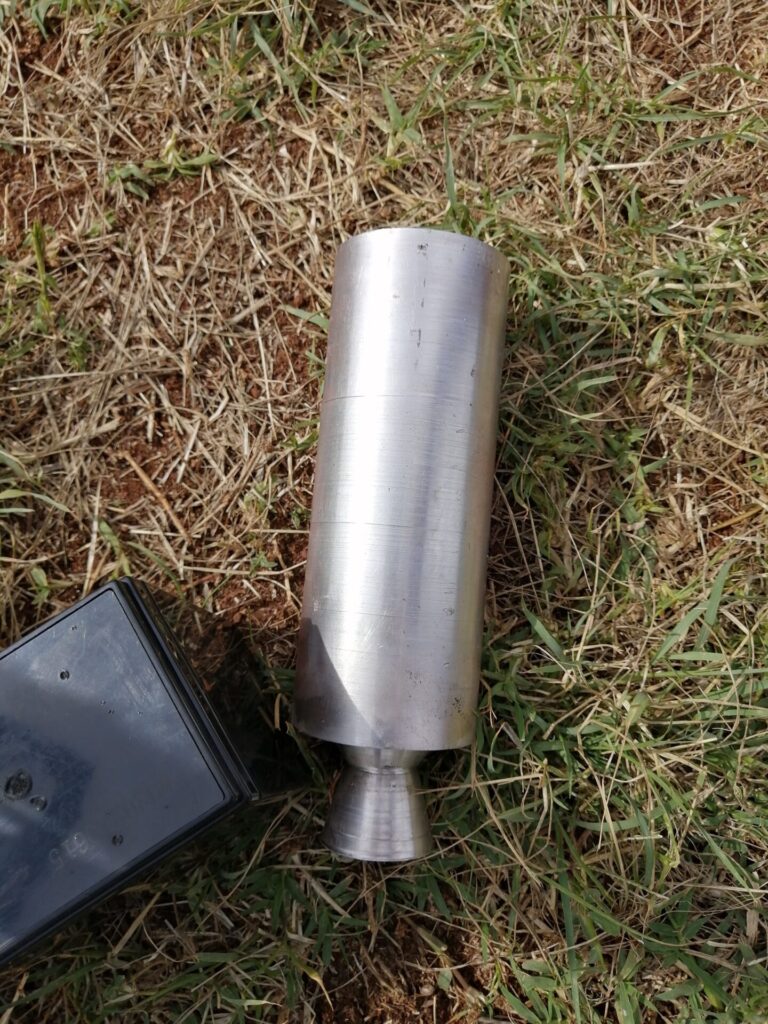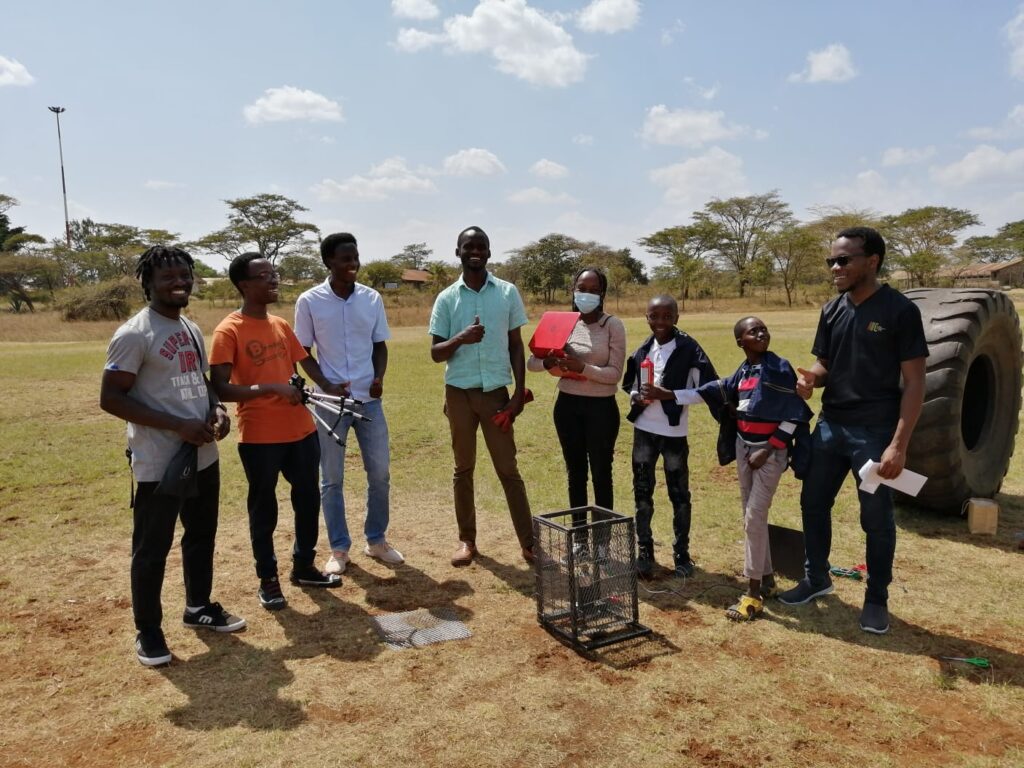Test flight of the N-2 rocket
This was the first test flight that we tried before going to Malindi, but were unable to fly it because we ran out of time. The electrical team was using a breadboard, which shorted out when they loaded the circuits inside the rocket, and combined with the fact that it was approaching 18:00, they had no choice but to give the order to abort the flight.
This time, we solved the problems that arose during the previous launch. The circuitry was made on a printed circuit board instead of a breadboard, and improvements were made to the launch pad and launch lugs (the parts that attach the rocket to the launch pad). The launch was scheduled to take place in the morning, but work was always delayed. Unfortunately, I had to go to the embassy in the afternoon, and after 1:30 p.m., I left the university, leaving another faculty member to supervise the launch. I am now just waiting for reports from the students.
Maybe before 5pm, I received a post to the team’s Whatsapp group. A video of the launch was shared.
It is flying well into the sky. I could feel the excitement of the team from the video. It was unfortunate that I could not be there for the launch. But it was great that the team was able to make it.
The students provided a comprehensive launch report in the following article.
Second Test Flight Report (nakujaproject.blogspot.com)
According to the above, the transmission of the aircraft information (flight log) from the avionics and its reception at the ground station seemed to go well. The concern is that the parachute did not open, and at least this problem should be resolved before the actual launch. According to the student’s report, the data received at the ground station showed no trace of the apogee detected, but there were signs that the pyrotechnic for the parachute ejection was activated. In any case, it seems that the blast from the explosives did not generate enough force to overcome the dynamic pressure. The fact that the nosecone was neck-deep in the fuselage suggests that the nosecone needs to be redesigned.
Visit Broglio Space Centre in Malindi
The Kenya Space Agency offered us to visit the Space Center in Malindi, and we were finally able to visit there with a team of over 30 people, including 3 faculty members from JKUAT, 21 students from Nakuja, 5 members of the nano-satellite development team, and also an intern from KSA. We are grateful to the Kenyan Space Agency for their kindness in covering the accommodations of the students. Despite some difficulties, we were finally able to obtain a school bus from our university. I would like to thank the university, especially the Deputy Vice Chancellor for his support, and the drivers who actually operated the bus. The trip was not short of topics, as the bus was unable to refuel in Malindi due to fuel shortages in Kenya, and an operation was carried out to have fuel delivered to the university to Mtito Andei, a stopover along the way.
The visit itself was very meaningful, and the biggest gain was that we were able to exchange opinions with people from the Italian space agency for the future launch of the rocket.

KSAからの出向エンジニア
今日からケニア宇宙機関からのインターンが3名Nakuja projectに参加することに。彼らとのコラボレーションが楽しみだ。
燃焼試験(KNSB)の進捗
第2コホート(2022年)のインターンによる燃焼試験が進んでいる。
第1回:2/22実施



推進剤中の水分、とくに液体ソルビトールに含まれる水分を十分に蒸発させて再トライすることに。
第2回:2/25実施


第3回:2/28実施


CuringはCasting後、通常1〜2日で完了する。放置が長すぎると硬化することが知られているが(5日程度で完全に硬化 by Nakka)、推進剤の性能も損なうようである。
第4回:3/1実施
最大推力は5N程度にとどまり、理論値の140Nとはかけ離れている(28倍の開き)。ただし計測値の信憑性が低いことが判明したため、次回の計測で検証する。
第5回:3/2実施

第2バッチのインターン生も参戦
計測された最大推力は60Nであり、理論値の140Nに近づいている。次はさらなる性能向上をねらって酸化剤リッチ(O/F = 68:32)で試してみる。ところで燃焼初期のCoughingが気になるところではある。

第6回:3/3実施
O/F比を高めて実験に臨む(O:F=68:32)。


最大推力は140Nを超えて160Nだった。設計の再確認を行うことに。
O/Fを少し低くして再実験する(O:F=67:33, 66:34)。
第7回:3/10実施
耐熱性から軟鋼で製造したノズルに換装して実験を実施。O:F比は67:33で、グレインを2つ搭載した。これにより、300N近くの最大推力が想定される。

試験は破壊的失敗に終わった。具体的にはノズルが脱落し、モータが破損した。



得られた推力曲線(ロードセルの仕様から、500N以上は信頼性に欠ける)

まとめ
- 最大推力は750N程度と出ているが、ロードセルの限界を超えているので信頼性に欠ける
- ノズルが分離したことは結果的に安全弁として機能した。チャンバーの圧力を逃がした。
- ノズルは遠くには飛ばず、テストスタンドのすぐ横に落下した
- テストスタンド、特に片持はりになっている部分が曲がった
- ケージが破損した
- 燃焼効率はほぼ100%であった
考えられる破損の原因
- 燃焼熱で燃焼室壁が溶けてしまった。ノズルとチャンバーの接続部周辺に穴が開いている
- 上記で空いた小さな穴の周辺に応力が集中し、チャンバー壁の変位をもたらした
- この変位によりチャンバーがノズルを保持できなくなり、ノズルを排出した。
改善点
- 燃焼熱からチャンバーを保護するための断熱を検討する。Nakkaのウェブサイトを参照する。
その後気づいたのがA7075の融点の低さ。A6063の融点615℃に対してA7075は477℃で融解する。そのため素材をA6063に変更することを検討した。材料の変更に伴い強度が低下するので、燃焼室の厚みを2mmから3mmに増加する必要がある。
一方で、シールが不十分なためにガスがノズルとチャンバーの隙間から漏れ、ノズルとチャンバーの不双方に過度な熱負荷が生じたという指摘があった。したがって次回の実験ではシールを強化し、A7075のまま実験を進めることになった。
第8回:3/18実施
失敗直後の実験で緊張したが、実験は成功した。概ね理論値に近い値が取得できた。KNSBが一歩完成に近づいた瞬間である。あきらめずにKNSBを追究した学生たちに拍手。


ケニアでよく聞く英語
- Kindly: Pleaseと同義だが、こちらのほうが頻繁に使われる。お願いします、という意味で単体で使われることもある。
- Through the chair: 議長に発言許可を求めるときに使う
- All the protocols observed: 紳士淑女の皆さん、〜(中略)〜「その他ご列席のすべての皆様」というときに使う
- can be able to: canと同じ意味。冗長に感じるが、よく使われる。スワヒリ語に対応する言い回しがあるのか?
- instrumental: useful, helpful, handyよりもこちらの方を良く聞く。
思いついたら随時追記する。